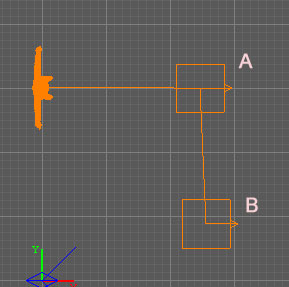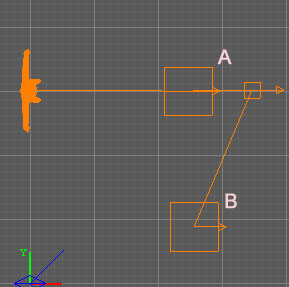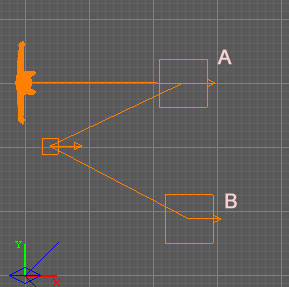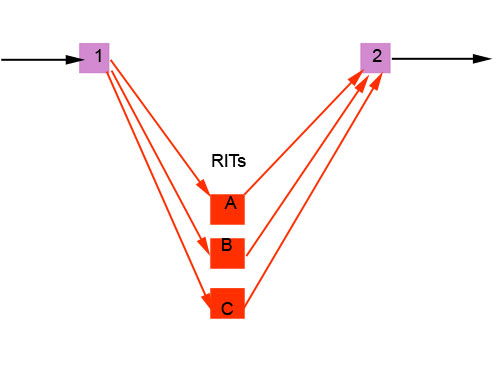Path Nodes: Difference between revisions
+monsterclip info on path_lookat, moved from untested section since used in multiple FMs now |
m →Flee Points: formatting |
||
| Line 228: | Line 228: | ||
"team" Only AI on this team would use this flee point. | "team" Only AI on this team would use this flee point. | ||
This is how the code works: | |||
* The AI tries to determine the nearest friendly guarded flee point and flee to it. | * The AI tries to determine the nearest friendly guarded flee point and flee to it. | ||
* If there is no friendly guarded flee point, the AI tries to find the nearest friendly flee point (on friendly team) and run to it. | * If there is no friendly guarded flee point, the AI tries to find the nearest friendly flee point (on friendly team) and run to it. | ||
| Line 244: | Line 244: | ||
Armed AI will also flee if their health points drop to a certain level? Where is that determined? | Armed AI will also flee if their health points drop to a certain level? Where is that determined? | ||
This is determined by the health_critical spawn arg. | This is determined by the health_critical spawn arg. | ||
= Untested Nodes = | = Untested Nodes = | ||
Revision as of 18:18, 23 January 2014
originally written by Springheel
For more information on pathfinding, see Pathfinding. For more general info on getting your AI to patrol, see AI Patrol.
What are Path Nodes?
Path entities (or path nodes) are the things that you use to make your AI move (patrol) around the map. Placing path nodes can take a little getting used to; hopefully this article will help (I'm far from an expert, but here's what I've discovered so far).
There are lots of different kinds of path nodes. It can sometimes help to think of them as "travel nodes" (nodes that AI will travel to) and "behaviour nodes" (nodes that tell AI how to behave at a certain point).
Although path nodes have a directional arrow in the editor, it has no impact on most nodes. Rotating the node does add a corresponding "angle" property to the entity (matching the direction of the arrow). Certain nodes (path_anim, path_wait, and path_turn, for example) are affected by the "angle" property, but most will ignore it.
How to use Path Nodes
Path nodes are placed like any other entity (RMB and select "add entity", then scroll to "paths"). They show up as a coloured box with an arrow in the editor (colour varies depending on config.)
Path nodes are useless if they are not linked to another entity (either an AI or another node). In order to link them, you use the "target" property. This tells the AI what path node they should go to (or act on) next. If you type "target" "path_corner_1" in your AI property list, then your AI will walk to "path_corner_1" when the map starts. Without a "target" property, your AI will not go anywhere. Once you add a "target" property to either your AI or another node, you should see a colored line connecting the two entities.
Behaviour nodes activate behaviour in order. In other words, if you want an AI to reach a path_corner, then turn to face a direction, then wait for a time, then play an animation, you need to link the nodes in that order.
path_corner ---> path_turn ----> path_wait ----> path_cycleanim -----> next path_corner
Variation and Randomness
It is also possible to target multiple nodes (using "target1", "target2" etc. spawn args). In this case, the AI will choose one of these nodes with equal probability. If the "chance" spawn arg (between 0 and 1) is set on a node, it defines the probability for the AI to choose this path node next when multiple path nodes are targetted. The chances at any point must not add to greater than 1, or it won't work properly. For example, if a path_corner targets two different nodes, you could set "chance" ".75" on one and "chance" ".25" on the other. This will result in AI choosing the first path 3/4 of the time.
There are now two new spawnargs, "alert_idle_only" and "idle_only" that can be set on path nodes. The nodes are then only chosen when the AI is in that state. For example, if you set a path_corner as "idle_only", then the AI will no longer go to that path node when it has been alerted. This allows the mapper to set a complete set of alternate patrols and actions for AI who have been alerted (like sending them to guard important areas). (for info on how to use Objectives to alter paths, see Objectives#Using_Objectives_Creatively)
Note that if an AI reaches a node that targets pathnodes that are unavailable (because they are idle_only, and the AI is alert, for example), the AI will stop and no longer proceed.
Nodes that make the AI walk to a specified location (currently the only one that does this is the path_corner) can have an "move_to_position_tolerance" spawn arg, which defines how close the AI has to be to the destination point to determine the position as reached. Normally, the AI considers the position reached as soon as it is inside its bounding box (most of our humanoid AI are using aas32, so the point would need to be within 16 units from the AI's origin). This is not always accurate enough, for example when a path_corner is placed in front of a chair where the AI is supposed to sit down, making the AI place half of their back next to the chair.
[Fidcal: I believe the accuracy spawnarg is replaced by the move_to_position_tolerance above. The following likely applies to the new spawnarg anyway.] Setting the accuracy spawn arg will change the horizontal size of the bounding box used for checking. If the accuracy is set to negative values (default is -1), the standard bounding box will be used as before.
This spawnarg is available for all entities and can also affect AIs moving towards levers or buttons.
Kinds of Path Nodes
path_corner
Probably the most common path node, this is a "travel node". AI will walk from their current position to this node in as straight a line as possible. This node must be on the ground and in an area AI can reach. See Pathfinding for more information on how to help AI go from one node to another.
To make AI patrol an area, each path_corner node can target the next one in sequence. If AI reach a node that does not target anything, they will stop there and no longer move without player interaction. It is possible for two path_nodes to target each other, which means the AI will walk from one to the other and back again endlessly.
A single entity (path node or AI) can target more than one path_corner; D3 will randomly choose between the targetted nodes. Use the following syntax: (actually this syntax needs to be double checked)
target path_corner_1 target2 path_corner_2
(At the moment, targetting more than 2 path_corners from the same entity does not seem to work (possibly a DR bug).
In the example below, both A and B are path_corner nodes. On map start, the AI will walk to A, then turn and walk to B, then stop.
Extra note: To make an AI run on patrol add the property/value : "run" "1" to a path_corner on the AI's patrol and the AI will run to it (then resume walking after it if the next path_corner does not have that property set.)
Note that an AI will return to a path_corner (does it choose the nearest or most recent?) after a failed search. If you do not have at least one path_corner, the AI will stop wherever they are when their search is complete.
Also note that if the AI is going to stop at a path_corner--perhaps to wait a spell--the path_corner origin should be kept at least 16 horizontal units away from monsterclip and worldspawn brushes. Otherwise, the stopping animation might not look right.
path_wait
This is a behaviour node. It does not tell an AI to move anywhere. This node tells an AI to wait in an idle state for a given amount of time. Once that time is up, the AI will proceed to whatever the next target is (a path_wait with no target is pretty pointless).
A path_wait node appears as a small orange box. It has a directional arrow, but that has no affect on which direction the AI faces in the first place. However, you can set the angle key on the path either by rotating the entity or by setting the key directly to make the AI turn and face this direction before starting to wait. Important: If the angle is 0 make sure it is actually on the entity and not just default.
A path_wait node should have a "wait" property, with the number of seconds the AI should wait there before proceeding. It can also have a "wait_max" property which will vary the repeat time. So for example...
* wait 30 * wait_max 40
...will cause the AI to wait between 30 to 40 seconds before proceeding. If wait_max is set to 0, the AI will always wait exactly the time specified in wait before proceeding. If you set wait to 0, the AI will wait between 0 seconds and the time specified in wait_max. Default values are 2 seconds for wait, and 0 seconds for wait_max, so the AI will always wait exactly 2 seconds.
In the following example, A and B are path_corners, and the small orange box is a path_wait entity. On map start, the AI will walk to A and wait there for the required amount of time, then turn and proceeds to B.
Note that it does not matter where the path_wait node is placed. The AI does not actually follow the orange lines (this is not really intuitive, I know). The example below would cause the exact same behaviour as the example above--in both cases the AI will walk directly from A to B.
Another useful example for path_wait is that of the stationary guard who turns to look in different directions periodically. This can be schematically represented (arrows indicate target links) as:
AI -> path_corner1 -> path_wait1 -> path_wait2 -> path_corner1
Example properties for the path_wait are:
wait: 5 (minimum time to wait on action) wait_max: 10 (maximum time to wait on action) angle: 0 (Important: this property is essential for proper function even if the angle is 0)
The AI walks to or stands at the path_corner. The next action is to do what is indicated by the first path_wait. In this example, it tells the AI to face a particular direction for a certain period of time. This then targets a second path_wait which has the AI face a different direction for a certain period of time. To complete the cycle, the second path_wait then targets the original path_corner. The path_corners are necessary because again, the path_wait doesn't contain pathing or location information. Without the path_corner, if the AI is caused to wander (e.g. becomes alerted), it might not return to the original standing spot, and instead will do the look angles right where it stands. The path_corner assures the AI returns to its original position.
path_turn
This behaviour node tells an AI to turn in place to face a chosen direction. It does not make the AI walk anywhere. This is the one node where the directional arrow does seem to matter--the AI turns to face the same direction as the arrow. Alternately, you can use the property "angle" and the values below:
- 0 = East (X)
- 90 = North (Y)
- 180 = West (-X)
- 270 = South (-Y)
- 360 = East(X)
(Actually, to be more accurate, rotating the entity automatically adds the "angle" property to the entity. If you just leave the arrow facing the way it is when you create the entity, there will be no "angle" property, and therefore the AI will not turn.)
path_anim
This is a behaviour node that makes the AI play an animation, once. When that animation is done, it proceeds to the next target (if any). This could be used to make an AI walk over to a bookshelf and play a 'reaching out' animation, for example. Other possibilities include peering through a window, picking a carrot off a table and eating it, or running to a spot and cowering.
The syntax proper syntax is:
anim [animation name]
You can see the list of animations names here: Animation List. Do not use the name of the actual animation file.
A path_anim can have only one animation, but it is possible for a single entity to target more than one path_anim. The AI will pick one of the path_anim nodes at random and play that animation.
When you first create the path_anim entity, the directional arrow is meaningless. However, if you rotate the entity, the "angle" property is added to the entity and is updated based on which direction the arrow is pointing. That property indicates the direction the AI will face while playing the animation. This value appears to be necessary to make the animation work.
Tip: Animation blending doesn't seem to do very much, so AI often "snap" into position from walking to playing the animation. For a more natural look, add a path_wait of a few seconds first, so AI transition to their idle pose before playing the animation.
path_lookat
This does not stop the AI, but they will turn their head and look somewhere specific as they walk to their next target. For the next wait seconds, turn head to look at the entity given by the focus spawnarg (defaults to looking at the path_lookat entity itself). This is useful if you want to make sure an AI is looking at a specific spot (or away from a certain spot) during their patrol. Note the focus entity must not be obscured by monsterclip.
path_sit
This is a behaviour node that makes the AI sit down at its current location. See Sitting Behaviour for AI for more information.
path_waitfortrigger
Waits at a given place until triggered, then proceeds to the next target. This is useful if you want some control over exactly where the AI is when the players first see it.
The "path_waitfortrigger" basically operates like a wall, blocking the AI from proceeding until triggered.
Here are the steps for future reference. Let's say you want an AI to stand somewhere until a player triggers him, then you want him to walk to path_corner 1.
1. Make a "path_waitfortrigger" pathnode, and have it target "path_corner_1".
2. Have the AI target the "path_waitfortrigger" pathnode.
3. Create a trigger_once entity, and target the AI.
The AI will stand where they are at map start and behave as if there are no pathnodes set (ie, he plays idle animations and can be alerted). When the player goes through the trigger, the "path_waitfortrigger" is cleared and the AI will proceed to path_corner_1.
I've tried a few different setups and gotten unusual results...more testing needed.
path_interact
This lets the AI interact with an entity (for example a button) in a similar way to frobbing. This will only work for buttons etc, not for inventory items and moveables. The AI will stop and look at the entiy while interacting, but not walk to it, so a path_corner next to the entity is required. AI will use normal doors and elevators without needing a path_interact (confirmation needed). However, this could be used to make AI turn on lightswitches, open mechanical doors, etc.
You need to add these spawnargs to the path_interact entity:
ent <name of entity to be frobbed by AI>
target <next path entity (if any)>
How to Make AI do Random Interesting Things (RIT)
by Sotha
You can use the above to make individual AI seem to do Random Interesting Things (RIT) when entering a room. Note that it will work with basic dendritic AI, so you could have multiple AI's running in several rooms doing things.
1) Build a room with RITs. A statue. A few chairs. Maybe a lit fireplace.
2) On each RIT place the necessary interaction path_nodes to make an AI interact with them: path_corner to walk over to them; path_sit on each of the chairs, path_anims for warming hands at the fireplace and standing in front of the statue and pondering, etc (A, B & C in image).
3) Place two path_waits (1 & 2 in image) on the ceiling of the room. (They could be anywhere in the room, but it is easiest to manage if they are in the ceiling.)
4) Name one of the path_waits "enter_room_decide_what_to_do." (1) From that path_wait target each of the RIT path_corners. Set the path_wait "wait 0". so AI won't stop there. The idea is to use the path_wait as a simple decision making node. Be sure that the path_wait has no angle-spawnarg. If it does, the AI will turn towards the angle each time he targets the node.
5) Name the other path_wait "exit_room_decide_what_to_do." (2) Make each RIT final path_node target this path_wait. Make the path_wait target other rooms with similar decision making path_waits.
6) Done.
AI will come into the room, select A, B or C at random, and then leave. Next time they enter, they'll again pick at random.
This could be used to make servants to run around a mansion, cleaning, making food, taking sitting breaks, visit the toilet, etc. You could build room decision making network separately for different AI. Servants clean, cook and take breaks. Guards patrol, make random deviations once in a while, and of course take breaks. Controlling the RIT path_corner chance-spawnarg gives you control what RITs the AI do more likely.
Please see the dedicated RIT network article for more details. RIT Networks
Switching from one Path network to another
Suppose you want to have an AI patrol outside a mansion for the first part of a mission, and then change his route to patrol in another location later?
It is possible to change the "target" property on a path_corner by using atdm:target_changetarget.
Target the atdm:target_changetarget entity at the pathnode you wish to alter. Use the following spawnargs:
"add" "[new path_corner]" and/or "remove" "[old path_corner]"
Then add a trigger that targets the atdm:target_changetarget.
When triggered, the new path_corner will be added and the old removed, sending the AI to a new path network. This no doubt has vast potential for variation and creativity that has yet to be explored. One simple example would be a "changing of the guard" moment, where some guards leave their posts and go to their barracks to sleep, while others take over for them.
Other ideas:
Doormen-- An AI (or the player) walks up to the door and knocks on it. AI inside is triggered to walk over to the door and open it, then go back to his regular duties.
Abandon ship! -- When triggered, all AI drop what they're doing and start running for the exits.
Lights out! -- At a specific time, all AI stop what they're doing and walk to their beds to go to sleep.
Re-use, recycle -- AI that are stuck back in a portion of the map the player won't be coming back to could be told to walk to a new portion of the map and assume some job there.
It's a trap! -- Player walks down a hall and hits a trigger that causes AI to quickly position themselves at the only exits.
Flee Points
Do NOT target the AI to a flee point; AI will automatically go to a flee point if in danger. Just make available path_flee_point entities at suitable places where you would like your AI to flee to.
On the path_flee_point entity:
"is_guarded" A fleeing AI, eg, a civilian, would give this preference (but it is up to the mapper to actually provide a guard there.)
"team" Only AI on this team would use this flee point.
This is how the code works:
- The AI tries to determine the nearest friendly guarded flee point and flee to it.
- If there is no friendly guarded flee point, the AI tries to find the nearest friendly flee point (on friendly team) and run to it.
- If this also fails, the AI tries to find an AAS area far from the enemy and run there.
- If the enemy is still visible when the AI reaches his destination, he chooses the farthest friendly guarded flee point to run to,
- if this fails, the farthest friendly flee point,
- and if this also fails falls back to choosing an AAS area far from the enemy to run to.
- So neither the priority nor the target spawn arg have any function here, it is not possible to weight the flee points. The AI will choose one automatically.
A problem occurs when the AI doesn't find any appropriate flee points but also no AAS area that is far away enough from the enemy. In this case, he will just stand there. Maybe he should either cower and be afraid in this case or just run around like a mad chicken?
Whether a fleeing AI passes on info to other AI as to the source of their alert (ie so armed guard would go to investigate to the right place whereas another civilan might also flee to the farthest point.) Yes, they do. The cry for help bark is propagated to other AI and carries information about the last alert position.
Armed AI will also flee if their health points drop to a certain level? Where is that determined? This is determined by the health_critical spawn arg.
Untested Nodes
I have not personally tested the following, so I'm just going by their editor descriptions. They may or may not work as described.
path_cycleanim
The AI stays in place and loops the selected animation, either for a specified amount of time (using the 'wait' property) or until triggered. Syntax needed.
path_hide
Supposedly deactivates and stops rendering the AI.
Turns out this doesn't work well with TDM...makes AI invisible but they still talk and occupy space. To remove an AI from the map, try grayman's approach:
Create a [b]func_remove[/b] with this spawnarg:
"target" "<AI's name>"
At the point in his path where you want him to disappear, place a [b]trigger_once_entityname[/b] with these spawnargs:
"entityname" "<AI's name>" "target" "<func_remove's name>"
When the AI walks through the [b]trigger_once_entityname[/b], it recognizes him, triggers the [b]func_remove[/b], and that takes the AI out of the game.
I wrapped the AI's final path corner in a trigger_once_entityname and gave the trigger the keyword pair "entityname <AI_name>". (The docs don't tell you about this key, but the game will error out if it's not there, and tell you it's missing. A classic "trial by error".)
path_show
Starts rendering the AI. I would assume this one would be linked to a path_waitfortrigger, to create AI that spawn when triggered. This could be used to create the effect that an AI just came through a doorway or around a corner.
path_attack
Used to script AI attacking a particular enemy, for scripted sequences I guess. AI will continue on to the next path entity if it kills the enemy.
Questions: How do you define who the AI attacks?
[Fidcal]: Just found this - "Character will attack the character specified by 'enemy' key. Character will go to next path when enemy dies or when activated." Not tested.



